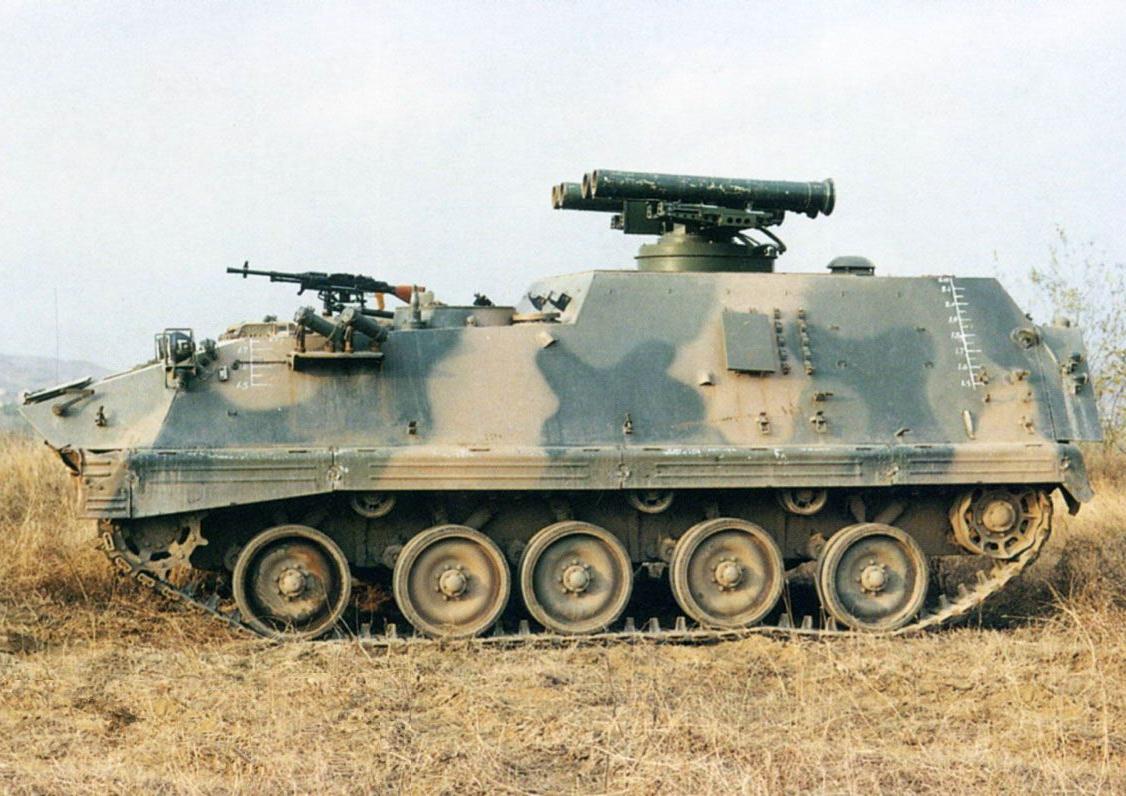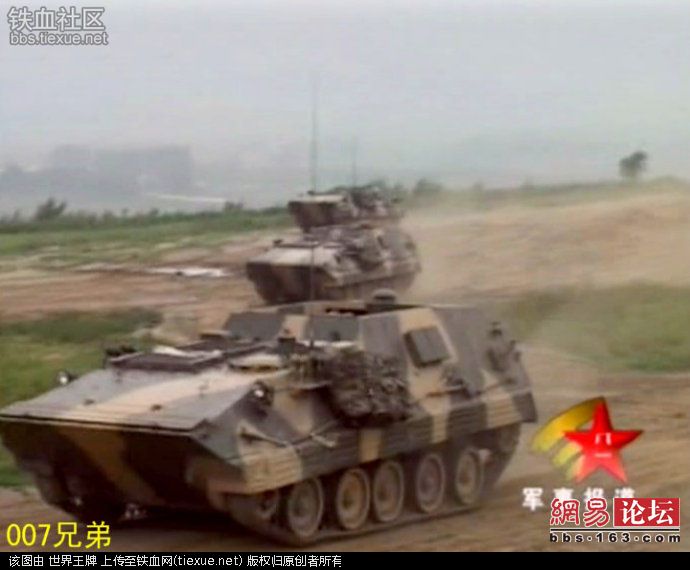- Yes
- No
Welcome to the suggestion post for the ZDF89!
What exactly is the ZDF89? For starters, the name itself stands for Zhihui Dao-dàn Fánghù, or Guided Missile Carrier, with the 89 seemingly carried over from the vehicle’s base chassis, a ZSD89 APC. From its name, you may already tell what this vehicle’s purpose is, a tank destroyer with anti-tank guided missiles. The missiles used on the ZDF89 are the HJ-8, HJ meaning Hóng Jiàn, or Red Arrow. These are carried in a launcher that can fire four of these off before having to reload, meaning a ZDF89 commander can take out several tanks before having to retreat. This can be aided with the use of smoke grenades mounted at the front sides of the hull.
Now that we know a little more about it, let’s find out how the ZDF89 came to be!
History
For much of the latter part of the 20th century, the People’s Republic of China’s mainstay anti-tank guided missile was the HJ-73, a copy of the Soviet 9M14. It was virtually identical to the 9M14, and relied on great accuracy and constant guidance from the gunner. While the HJ-73 was improved with SACLOS guidance and a tandem warhead with better penetration, the design itself began to age. By the 1980s, new missiles such as the American TOW were being used in growing numbers, as well as European and Soviet counterparts such as the MILAN, HOT, 9M111, and 9M113. Due to this, the People’s Liberation Army desired a successor to the outdated HJ-73 design, ideally a portable design that could be improved over time.
 An HJ-73 being fired by PLA troops.
An HJ-73 being fired by PLA troops.
Development on a new missile had begun as far back as 1970, but due to political turmoil from the Cultural Revolution, any significant progress was slowed, if not outright halted. Despite this, Research Institute 203 and 282nd Factory still began work on the new anti-tank guided missile under the direction of designers Wang Xingzhi and Zhao Jiazheng. It wasn’t until 1984 that it was approved for production and service as the Red Arrow 8, or HongJian-8, HJ-8 for short. These many years of development resulted in a SACLOS and wire-guided missile launched from a tube. Similar to its counterparts, it was versatile and utilized in several ways, including mounting on helicopters, a man-portable launcher, and on ground vehicles. It would be exported to Pakistan, which most notably license produced it as the Baktar Shikan. Several variants would be made, with the penultimate anti-tank variant being the HJ-8L, which was much lighter and had far greater penetration than the initial production versions.
An HJ-8 being used by a People’s Liberation Army Navy Marine. A variety of HJ-8 variants.However, even before the ATGM was mass produced, it was mounted on light-wheeled vehicles, such as the BJ212 family of jeeps. This was highly advantageous, given the vehicle could move fast, get into position, and fire off an anti-tank missile before moving to a new area. However, some PLA officers were concerned about the off-road performance of a vehicle like this. Their concerns were mainly how such a vehicle could operate in an area like Southern China, which had a lot of rough and wet terrain. Owing to this, the idea floated around of putting the missile on a tracked chassis as a dedicated tank destroyer, something that could take small arms fire, provide better performance off-road, and provide a more stable platform for the missile.
A Beijing jeep equipped with an HJ-8 in use.With official approval, 201 Institute of NORINCO, also known as China North Vehicle Research Institute, soon developed a concept demonstrator vehicle in December 1982 using the Type 63 APC as a platform. After long-distance driving tests and multiple missile launch tests, to further improve the anti-tank capabilities of the vehicle, 201 institute decided in March 1984 to change the original single-tube launcher to a quadruple-mounted one and developed a prototype of such a vehicle in November 1985.
The prototype with the four-tubed launcher, differentiated from the finalized ZDF89 by the four road wheels and generally smaller size.In May 1986, the General Staff of the People’s Liberation Army and the Commission for Science, Technology and Industry for National Defense held a meeting about approving the HJ-8 ATGM Carrier for engineering development. At the same time, it was agreed that a new and more robust chassis should be used, specifically the new ZSD89 APC. The ZSD89, still in development at this time, was a lengthened and improved Type 85 APC, which was itself based on the Type 63 APC. Not only was it roomier inside, but the front of the vehicle became sharper and longer, increasing the chance of deflecting fire. The rear being roomier is likely one of the reasons it was chosen for the ZDF89 project; it was necessary to have enough space to fit both spare missiles and the crew. The ZSD89 is also amphibious, able to go at a steady speed of 6 km/h in water. To do this, a folding trim board stowed at the front of the hull needs to be raised, and the vehicle can then propel itself in water using its tracks.
A basic ZSD89 APC, fitted with smoke grenade launchers and a 12.7 mm Type 54 machine gun.With consideration for the ease of use and maintenance requirements of the ZSD89 APC, in July of 1986 it was proposed that the launcher be changed from a turret to a hydraulic-powered weapon station. This system would bring missiles up from the hull to the launcher instead of the crew getting out and reloading the launcher with ATGMs, exposing themselves to potential enemy fire. After consultations between the military and the R&D team, the vehicle’s design, now with a quadruple-mounted launcher, was finalized. In October 1987, a prototype vehicle was trial-produced, tested with live ammunition, achieving satisfactory results.
In December, the first prototype vehicle was transported to the northeast region of China, known for being cold. The tests now focused on hydraulic lifting, driving with the missiles on the launcher, and environmental adaptability. Because of the problems found in the initial prototype vehicle, the researchers trial-produced two modified prototype vehicles in April 1988, which were formally submitted to the military for design and finalization tests. The two prototype vehicles underwent tests in areas of varying temperatures, conducting driving tests, missile flight tests, and reliability tests at a Chinese weapons test center, which proved that the vehicle’s performance, at last, met the requirements of the PLA. In March 1990, the vehicle passed design and finalization requirements and subsequently approved for production in July of the same year as the ZDF89 Tracked Anti-Tank Missile Launch Vehicle.
The ZDF89 with its launcher out.With its missiles in the vehicle, the ZDF89 looks similar to the ZSD89 APC, except the raised hull rear to store the launcher and extra missiles. A four-man crew operates the ZDF89, a driver, loader, commander, and gunner, with the engine compartment located at the front right of the hull. The driver is to the left of the engine compartment, with the commander seated behind him. In the fighting compartment in the rear sits the gunner and his weapons station, with the loader located at the rear of the vehicle along with spare missiles. The crew are also protected by a collective NBC protection system in the pressurized and filtered hull.
The ZDF89 features an integrated weapon station containing an observation/fire-control unit and four tube missile launchers. When in travel mode or out of missiles, the weapon station can be retracted back inside the troop compartment. The ZDF89 carries four ready-to-launch missiles on the weapon station and eight spare missiles inside the hull. The station has an elevation from -10 / 10° with -200° to 200° of horizontal traverse. The gunner sits in the troop compartment with the loader when traveling, and enters the combat compartment when the weapon station is raised to the launch position. The missile launch mechanism is automatically locked unless all hatches and observation ports are shut, to avoid damage by the missile’s thrust during launch.
The gunner searches and locates targets using a periscope optical sight with a 7 km range. Once the missile is launched, the operator continues aiming their sight at the target. The TV goniometer measures the angle deviation between the missile and the line of sight. The correction command is sent to the missile via the wire. During the missile’s flight, the weapon operator only needs to keep the sight’s cross-hair on the target, and the system automatically transmits the command signal to the missile until it hits the target. Early variants of the ZDF89 lacked night vision for all-weather, day/night capability, however later vehicles may have been upgraded with this capability. For close-range defense, the ZDF89 featured a 7.62mm Type 67 mounted on the commander’s cupola and two four-barrel smoke-grenade launchers on both sides of the vehicle.
The ZDF89 in driving position. Similar to many other ATGM vehicles, the launcher has to be put away when the vehicle moves.Despite its lengthy development process, the ZDF89 seems to have had limited service with the PLA, being replaced with other types of tank destroyers, such as the PTZ89 and, later, the AFT-09 ATGM Carrier. However, the experience gained from developing the ZDF89 helped immensely with creating vehicles used even today, and it will likely be remembered as a big step forward.
An AFT09 ATGM carrier from the Nanjing Artillery Academy firing an HJ-9 ATGM during a live fire exercise, June 2015.Specifications
- Crew: 4 (Commander, gunner, loader, driver)
- Length: 6.15 m
- Height: 2.7 m
- Width: 3.1 m
- Armament: 4x tubed HJ-8 ATGM launcher (4 in launchers, 8 stowed) & 7.62 mm Type 67 machine gun
- Elevation and traverse angles: -10 / 10 degrees with -200 / 200 degree traverse
- Engine: Deutz BF8L 413F 4-cycle air-cooled diesel, 320 hp
- Operational Range: 300 km
- Maximum speed: 66 km/h (6 km/h in water)
Sources
In Chinese:
In English























